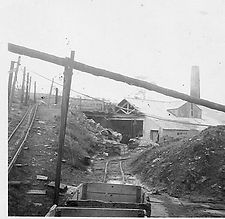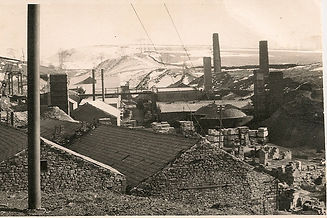The early years
In 1886 William Hammond took over the business. At the time Hammonds were manufacturing white glazed bricks and running the Bakestonedale colliery. However, a fire burned down the glazing shed and days later a fault on the pit winding engine led to the cage crashing into the shaft; damaging the shaft and trapping the miners for a number of hours. Hammonds rebuilt the sheds, but discontinued making glazed bricks, changing to fire bricks, fire backs and fire clay tiles.
William Hammond senior died in 1913 and was succeeded by two sons; William Hammond junior, running the Brickworks, and Percy Hammond running the mines.
A short history of the Old Brickworks
The area around Pott Shrigley is ideally suited to brick manufacture. Underneath Bakestonedale moor there are three seams of coal and two of clay, which have been mined for over two centuries.
Before Hammonds
Around 1820 the first small brickworks was started on site by George Lambert and Abraham Bury; using locally mined clay and coal and firing the bricks in a small kiln. In 1870 William Hammond jointed the Gardiner family working the clay and coal seams.

The war years
During the First World War brick production increased and Hammonds started to employ local ladies to make bricks as most of the men had been called up. In 1916 Hammonds was bombed by a Zepellin airship. A night watchment spotted the incendiary bomb and extinguished the fuse with his boot. The watchman was so proud of his actions that he wanted to take the bomb home as a souvenir. Luckily he was prevented from doing so by the authorities who removed the unexploded bomb!
During the Second World War Hammonds again went into war service and again local women were recruited to make bricks. Coal production was stepped up and the surrounding woodlands were felled, on ministry orders, to make pit props. After the war Eric Hammond joined his father at the Brickworks. At this time William Hammond Ltd were selling their bricks worldwide; to South African and Rhodesia for the railways and even to Australia to build the Commenwealth's rocket range at Woomerra.
At its peak the brickworks employed 120 people as miners, brick makers, pattern makers, yard men, stockers and staff.
The recent past
Inevitably brick making declined and Hammonds started to diversify. Mining ceased in 1956 and in 1963 the mine shafts were filled and capped. William Hammond Ltd ceased making fire bricks in 1968. However, the company continued to manufacture refractory cement and chemicals until the 1990s.
Over the last 35 years the current management under Colin Hammond (Eric's son) have undertaken extensive efforts to replant the woodland and to date over 2000 trees and shrubs have been planted. The old brickmaking sheds have been refurbished, new units built and the infrastructure upgraded. These units are now let out to small businesses.
As we move forward we are keen to further improve the land and to make the business as sustainable as possible


